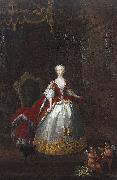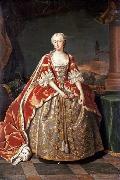
|
William Hogarth
|
|||
|
|
|||
| British 1697-1764 William Hogarth Galleries Early satirical works included an Emblematical Print on the South Sea Scheme (c.1721), about the disastrous stock market crash of 1720 known as the South Sea Bubble, in which many English people lost a great deal of money. In the bottom left corner, he shows Protestant, Catholic, and Jewish figures gambling, while in the middle there is a huge machine, like a merry-go-round, which people are boarding. At the top is a goat, written below which is "Who'l Ride" and this shows the stupidity of people in following the crowd in buying stock in The South Sea Company, which spent more time issuing stock than anything else. The people are scattered around the picture with a real sense of disorder, which represented the confusion. The progress of the well dressed people towards the ride in the middle shows how foolish some people could be, which is not entirely their own fault. Other early works include The Lottery (1724); The Mystery of Masonry brought to Light by the Gormogons (1724); A Just View of the British Stage (1724); some book illustrations; and the small print, Masquerades and Operas (1724). The latter is a satire on contemporary follies, such as the masquerades of the Swiss impresario John James Heidegger, the popular Italian opera singers, John Rich's pantomimes at Lincoln's Inn Fields, and the exaggerated popularity of Lord Burlington's prot??g??, the architect and painter William Kent. He continued that theme in 1727, with the Large Masquerade Ticket. In 1726 Hogarth prepared twelve large engravings for Samuel Butler's Hudibras. These he himself valued highly, and are among his best book illustrations. In the following years he turned his attention to the production of small "conversation pieces" (i.e., groups in oil of full-length portraits from 12 to 15 in. high). Among his efforts in oil between 1728 and 1732 were The Fountaine Family (c.1730), The Assembly at Wanstead House, The House of Commons examining Bambridge, and several pictures of the chief actors in John Gay's popular The Beggar's Opera. One of his masterpieces of this period is the depiction of an amateur performance of John Dryden's The Indian Emperor, or The Conquest of Mexico (1732?C1735) at the home of John Conduitt, master of the mint, in St George's Street, Hanover Square. Hogarth's other works in the 1730s include A Midnight Modern Conversation (1733), Southwark Fair (1733), The Sleeping Congregation (1736), Before and After (1736), Scholars at a Lecture (1736), The Company of Undertakers (Consultation of Quacks) (1736), The Distrest Poet (1736), The Four Times of the Day (1738), and Strolling Actresses Dressing in a Barn (1738). He may also have printed Burlington Gate (1731), evoked by Alexander Pope's Epistle to Lord Burlington, and defending Lord Chandos, who is therein satirized. This print gave great offence, and was suppressed (some modern authorities, however, no longer attribute this to Hogarth). | |||
|
|
|||
|
Portrait of Augusta of Saxe-Gotha new24/William Hogarth-764538.jpg Painting ID:: 76491 |
from 1736(1736) until 1738(1738) Oil on canvas cjr | ||
|
|
|||
|
Jean Baptiste van Loo
|
|||
|
|
|||
| Flemish Painter, 1684-1745 was a French subject and portrait painter. He was born in Aix-en-Provence, and was instructed in art by his father Louis-Abraham van Loo, son of Jacob van Loo. Having at an early age executed several pictures for the decoration of the church and public buildings at Aix, he was employed on similar work at Toulon, which he was obliged to leave during the siege of 1707. He was patronized by the prince of Carignan, who sent him to Rome, where he studied under Benedetto Luti. Here he was much employed on church pictures, and in particular executed a greatly praised Scourging of Christ for St Maria in Monticelli. At Turin he painted Charles Emmanuel II, Duke of Savoy and several members of his court. Then, moving to Paris, where he was elected a member of the Acad??mie Royale de Peinture et de Sculpture, he executed various altar-pieces and restored the works of Francesco Primaticcio at Fontainebleau. In 1737 he went to England, where he attracted attention by his portrait of Colley Cibber and of Owen McSwiny, the theatrical manager; the latter, like many other of van Loo's works, was engraved in mezzotint by John Faber Junior. He also painted Sir Robert Walpole, whose portrait by van Loo in his robes as chancellor of the exchequer is in the National Portrait Gallery, London, and the prince and princess of Wales. He did not, however, practise long in England, for his health failing he retired to Paris in 1742, and afterwards to Aix, where he died on 19 December 1745. | |||
|
|
|||
|
Portrait of Augusta of Saxe-Gotha new24/Jean Baptiste van Loo-595489.jpg Painting ID:: 77970 |
Date ca. 1742(1742) Medium Oil cyf | ||
|
|
|||
|
Also Buy::. For Following Paintings / Artists / Products, Please Use Our Search Online: |









